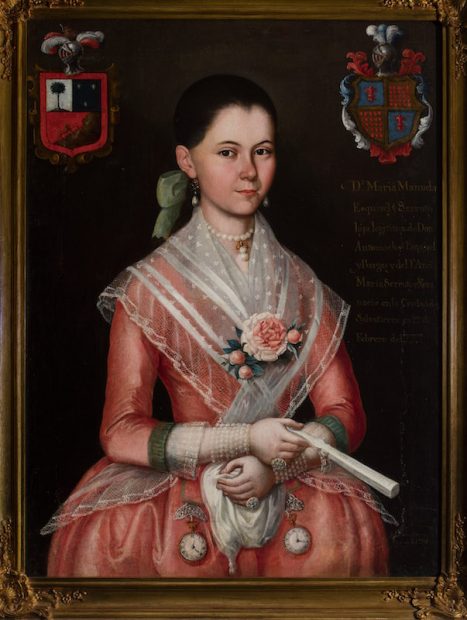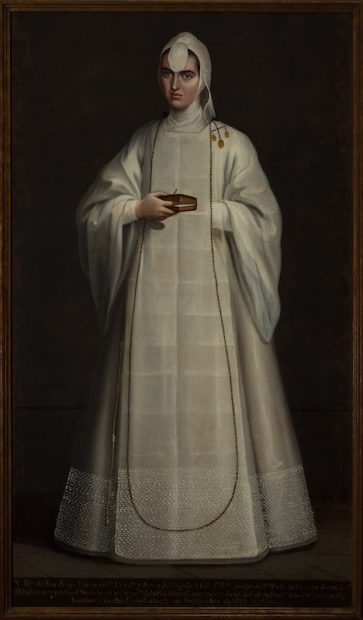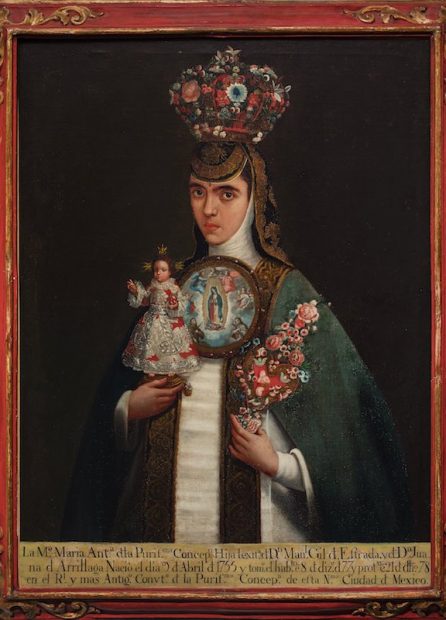
Artist unknown, New Spain, Sister María Antonia of the Immaculate Conception (Sor María Antonia de la Purísima Concepción), late 18th century
The beloved city of San Antonio is celebrating its 300th birthday this year. On May 1, 1718, Martín de Alarcón, Governor of Coahuila y Tejas, and Fray Antonio de San Buenaventura y Olivares established the first iteration of Mission San Antonio de Valero — the Alamo — near San Pedro Springs. The area had been named San Antonio de Padua by other Spaniards in 1691.
Arts activity as diverse as the city’s population itself is underway to commemorate the milestone. The San Antonio Museum of Art, housed within the glorious vintage brick façade of the former Lone Star Brewery, chose the least visually documented third of the centurial triptych for its contribution to the celebration. San Antonio 1718 – Art from Viceregal Mexico presents more than 100 paintings, sculptures, and devotional and decorative items that collectively excavate the story of life in northern New Spain before revolution resulted in the creation of an independent Republic of Mexico in 1821. Comprised of works — many previously unseen in the United States — from nearly two dozen institutions and private collections throughout Mexico, the exhibition is a stunning assemblage.
Marion Oettinger Jr., the museum’s Curator of Latin American Art, spent five years on a south-of-the-border “treasure hunt” to create San Antonio 1718. But it’s really an achievement that has been some 40 years in the making for the curator. Museum Director Katie Luber described it as “a monument to Marion’s work.” Oettinger added, “The exhibition is singular in importance for the manner in which it explores and illustrates the historic bonds between Texas and Mexico. Working on it has been the greatest honor of my career.”
In addition to the Spanish Governors Palace, the San Fernando Cathedral, and the Alamo, the four missions along the southern stretch of the San Antonio River provide the city’s primary evidence of its 18th-century, Spanish Colonial-built environment. And, Oettinger explained, except for a handful of baptismal fonts and a statue of Saint Joseph (the latter included in the exhibition), there remains no art in San Antonio from the Spanish Colonial era. Divided into three sections — “People and Places,” “The Cycle of Life,” and “The Church” — the exhibition includes some of New Spain’s most important 18th-century painters, including Cristόbal de Villalpando (1649–1714), Miguel Cabrera (1695–1768), and José de Páez (1720–1790).
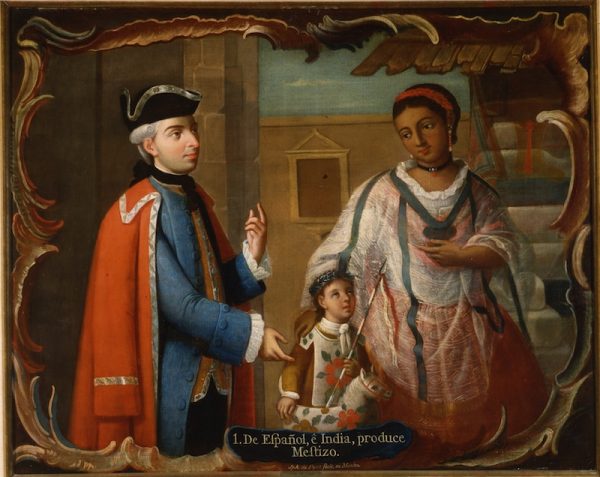
Jose de Páez (New Spain, 1720-1790), De Español e India produce Mestizo, from series of Mexican Castes, ca. 1780
A grid of 15 “caste paintings” by de Páez signals the entryway to “People and Places.” Oettinger explained that this genre became popular in the 18th century to demonstrate to authorities in Old World Spain that, although racial mixing, or mestizaje, was practiced in New World Spain, Spaniards, or Españoles, remained the social elite. Thus, as the castes’ rankings descended, Españoles who mixed with Indians produced Mestizos. Indians and Mestizos produced Coyotes. Spaniards and persons of African descent produced Mulatos. And so on. “The earliest censuses in San Antonio were organized by caste,” Oettinger added. “But it was a fluid system. A person with 100 head of cattle might be listed as a Mestizo, but 10 years later he might have 1,000 head of cattle and be an Españole.” Shown here, De Español e India produce Mestizo, the first of the set of 15 Mexican Castes paintings, depicts an Españole and an Indian with their offspring, a Mestizo. The paintings are rich with details of each caste’s station, including toys, attire, food, furnishings, etc. The lower castes’ homes are sometimes jacales with doors made of carrizo reeds.
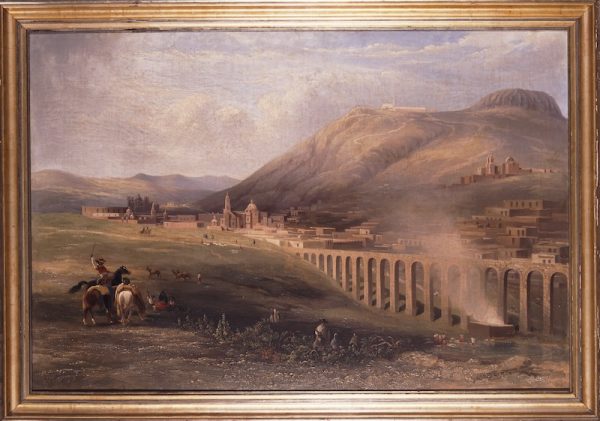
Daniel Thomas Egerton (England 1797-1842), View of Zacatecas from the Aqueduct (Vista de Zacatecas desde el acueducto), 1838
Spanish Colonial landscape paintings of the northern provinces were quite rare, the curator explained. If we could shrink the mountains to be low-slung hills, the cathedrals, missions, and small homes and shops of adobe and stone in View of Zacatecas from the Aqueduct by English landscape painter Daniel Thomas Egerton might give an idea of San Antonio’s appearance in the late 18th and early 19th centuries. The aqueduct itself recalls the Mission Espada Aqueduct of the Alamo City.
Portraits in “The Cycle of Life” section include the lovely María Manuela Esquivel y Serruto by Ignacio María Barreda. A young criolla woman of high social standing in New Spain, she wears silk, lace, and expensive jewelry, and the fully opened rose on her chest is a symbol of the subject’s coming of age. Her fan, an instrument of flirtation, is in the resting mode in this pose, yet ever at the ready.
![José María Guerrero (New Spain, active end of 18th – early 19th century) Martín, the Giant (El gigante Martín [Martín Salmerón y Ojeda]), 1796](https://glasstire.com/wp-content/uploads/2018/03/II-18-Gigante-M_MNH-388x620.jpg?x88956)
José María Guerrero (New Spain, active end of 18th – early 19th century), Martín, the Giant (El gigante Martín [Martín Salmerón y Ojeda]), 1796
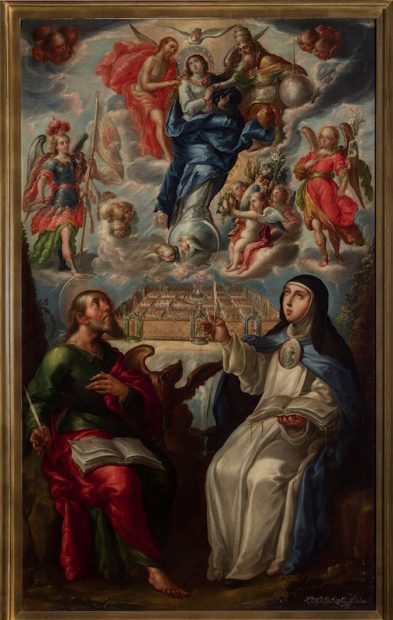
Cristóbal de Villapando (New Spain, 1645-1714), The Mystical City of God (La Ciudad mística de Dios), 1706
The 1706 painting, The Mystical City of God by Cristόbal de Villalpando depicts the 17th-century Spanish mystic Sor María de Ágreda gazing upwards toward a vision of Mary, the Virgin of the Immaculate Conception. As Mexico City art historian Jaime Cuadriello notes in the exhibition catalogue, the Virgin is presented as a metaphor for the Mystical City. After taking religious vows at the age of 18 in 1620 and taking the name María de Jesús, the young nun, still living in Spain, began to fall into trances. Known as the mysterious Lady in Blue in southwestern history and folklore, María de Jesús experienced hundreds of dreamstate bilocations in which she appeared in West Texas and New Mexico to evangelize indigenous populations. Jumano Indians reported to authorities in New Spain that they had been visited by a Lady in Blue, who inspired them to seek religious instruction.
It is believed that The Mystical City of God was commissioned by Fray Antonio Margil de Jesús. Informally regarded as “the patron saint of Texas,” Margil strode great distances across New Spain sans footwear. He lived in San Antonio in the early 1720s and founded San José y San Miguel de Aguayo Mission. In a broad sense, we might note that the humility evinced in his chosen title, first spoken in his boyhood, of “Nothingness itself” aligns with tenants of some Eastern philosophies. Margil might indeed blush to learn that no fewer than four images of himself grace the galleries of San Antonio 1718.
Oettinger described the 1760 painting Sor Ana María de San Francisco y Neve as the best portrait in New Spain for its “simplicity and elegance.” Though unsigned, it may be the work of either Miguel Cabrera or José de Páez. It depicts Sor Ana María as a novice in the Convent of Santa Rosa de Viterbo in Querétaro, before she had taken her final vows.
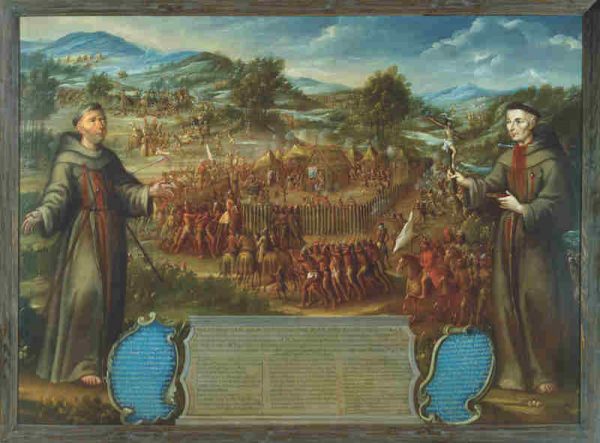
José de Páez (New Spain, 1720-1790), Martyrdom of Franciscans at Mission San Saba (El Matirio de los Franciscanos en la Misión de San Sabá), ca. 1765
The 1765 work, Martyrdom of Franciscans at Mission San Saba, by José de Páez is regarded, aside from petroglyphs and pictographs, as the earliest known painting depicting a scene in Texas. Oettinger characterized it as “the most important painting ever exhibited in Texas.” The large canvas dramatizes and chronicles the destruction of Mission Santa Cruz de San Saba, near present Menard, by a large party of Comanches and other Native Americans on March 16, 1758. The mission, its accompanying presidio unwisely located some four miles away, was established in 1757 to evangelize Apaches and other indigenous peoples. A text in the bottom center of the painting provides a key to scenes depicted, including the tribes’ approach, attack, plunder of the modest mission, and the killings of Franciscan priests Alonso Giraldo de Terreros and José de Santiesteban Aberín. Martyrdom of Franciscans at Mission San Saba is believed to have been commissioned by a cousin of Fray Terreros, Don Romero de Terreros, a mining magnate who had also financed Mission San Saba. On loan for San Antonio 1718 from the Museo Nacional de Arte in Mexico City, the painting itself endured a remarkable odyssey in the late 20th century.
According to Richard Scott White’s 2000 Texas Tech dissertation in Fine Arts, a descendant of the Terreros family sold the painting, which White titles The Destruction of the Mission San Saba, to a Mexican art dealer in 1980 for $10,000. Then it was resold to an international dealer who shipped the painting to Spain. When it sold again in late 1981, the price was $500,000, and it was brought into the United States at Miami, reportedly rolled up and carried under the dealer’s arm. Though its value was soon reassessed at one million dollars, it was regarded as unsaleable due to the lack of any import/export documentation. In 1984 and 1985, the painting was inexplicably on display at the Dallas Public Library. The following year, an Austin rare book dealer was engaged to market the piece. She approached the Mexican government, seeking formal permission to sell the historic work, and approached officials at the Texas Capitol about buying it for the statehouse. The Mexican Consulate got wind of the situation and alerted U.S. Customs that the art was in the country illegally. An investigation followed with at least one undercover art historian, and in November 1989, Customs agents and Austin police appeared at the book dealer’s home and seized the painting. At trial, the book dealer had her legal fees paid and received a purchase price for the art that came from seized drug funds, according to White. The Tonkawa Indian Tribal Council of Oklahoma registered its own unsuccessful claim to the painting, asserting, “The San Saba Mission was established for our Tribe by a treaty with Spain, before the Mexican government even existed… and the majority of the 400* residents massacred in 1758 were our tribe members. Our Tribal Government is claiming this painting as an Artifact because of its great cultural value to our tribe.” Before its eventual return to Mexico, Martyrdom of Franciscans at Mission San Saba hung in the Museum of Fine Arts, Houston from 1990 to 1992. Archeologists did not definitively identify the actual site of Mission San Saba until the mid-1990s. But their findings confirmed that the painting is a relatively accurate representation of the mission with its wooden jacales and thatched roofs.

Artist unknown, New Spain, Virgin of Guadalupe with Four Apparitions (Virgen de Guadalupe con las Cuatro Apariciones), mid-18th century
Among the holy relics destroyed in the conflagration at Mission San Saba, it’s likely the Franciscans lost at least one artwork depicting either the Virgin of the Immaculate Conception or her New World manifestation, the Virgin of Guadalupe. Among the eight works representing these figures in the exhibition, Traveling Altar with the Virgin of Guadalupe with the Four Apparitions is unique. Oettinger identifies the “somewhat enigmatic portable altar” as “the marriage of two works of art.” The Virgin of Guadalupe paintings, by an unknown artist in 18th-century Mexico, are framed within a lacquered wooden niche inlaid with mother-of-pearl that was likely fashioned in 16th-century Japan. It’s a blending of Japanese art materials with European content known as Namban. Attached to the back of the altar is a manuscript dated 1786, notes Oettinger, “stating that forty days of indulgence for the remission of sins are offered to persons who pray in front of this niche to the Virgin of Guadalupe.”
Among the many San Antonio mysteries that have long beguiled me is the modest 18th-century home that came to be known as the Veramendi Palace. Fernando Veramendi, born in Spain in 1743, traveled to the New World around 1770, became a successful merchant, and married into a San Antonio family of Canary Islanders in 1776. A son, Juan Martín de Veramendi, became governor of Coahuila and Texas, and a granddaughter, Ursula María de Veramendi, married James Bowie. Fernando Veramendi was killed by Mescalero Apaches near the presidio of San Juan Bautista while on a business trip to Mexico City in 1783. The Veramendi Palace became a museum in the late 1800s and was torn down in 1909. Though the family and the home are not referenced in San Antonio 1718, I feel as though I have somehow gotten closer to their world by seeing the exhibition.
I will be making a return trip to spend more time with San Antonio 1718. I especially appreciate the fact that it combines folk artwork with what Oettinger called “academic” paintings, which I hadn’t fully grasped until he pointed it out. Several 18th-century maps of San Antonio in the exhibition and catalogue also serve to increase our glimpsed and flickering knowledge of the villa’s most distant past. But above all, the curator most wanted us to know, “There was life in San Antonio… before the Alamo.”
‘San Antonio 1718 – Art from Viceregal Mexico’ continues at the San Antonio Museum of Art through May 13, 2018.
*Other sources indicate that the number killed in the attack was much smaller.


